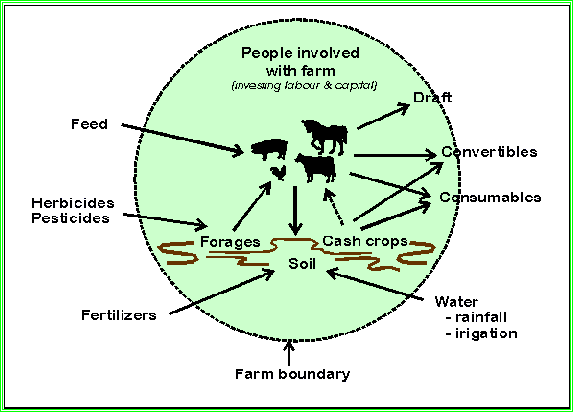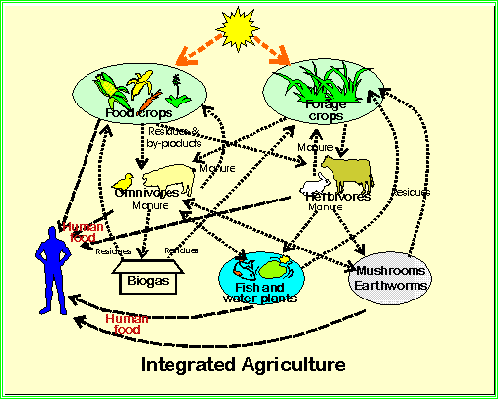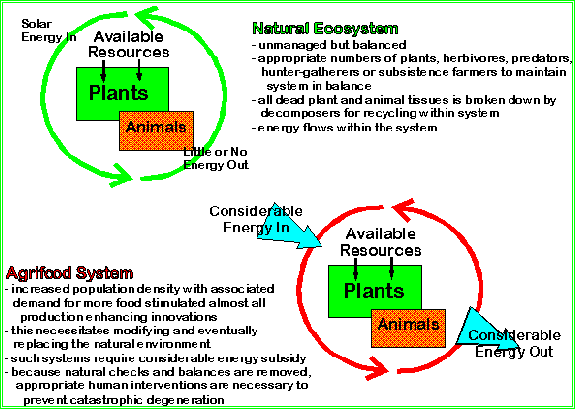

Gordon King, Animal Science, University of Guelph
"--- that once plants and animals were raised together on the same farms - which therefore neither produced unmanageable surpluses of manure, to be wasted and to pollute the water supply, nor depended on such quantities of commercial fertilizer. The genius of American farm experts is very well demonstrated here: they can take a solution and divide it neatly into two problems." [Berry, W. 1977. The Unsettling of America: Culture and Agriculture. Avon. New York]
A community of interacting organisms within their physical environment (habitat) make up an ecosystem. Green plants, with their photosynthetic capabilities, are the converters. They form the basis of all such biological communities by capturing solar energy and transforming it into chemical energy. The consumers, such as insects, birds, animals and humans, must feed on plants to obtain essential nutrients for growth and all other activities since they lack ability for photosynthesis. In turn, both plants and animals die, succumbing eventually to decomposers (bacteria & fungi) who break down complex tissue into simple elements, making the material again available for recycling. The sequence in which particular members of an ecosystem feed on one another is a food chain. Many, many different converters, consumers and decomposers inhabit a natural ecosystem, giving rise to numerous short food chains and long food chains.
All of the interconnected and overlapping chains within an ecosystem form a food web. Conflicts abound within such communities with many individuals and species surviving because they compete successfully with their neighbors. Others are less successful and extinction is not uncommon, even though the system's balance is maintained.
Many agricultural practices seriously disrupts the dynamic equilibrium of a natural ecosystem since almost all crop species are not native to many of the regions in which they are planted. Also, agronomy involves preparation of a special bed for planting, supplementation of solar energy with fertilizers, protection from competition by mechanical or chemical means, and export of some portion of the output completely out of the local system. Similarly, animal agriculture often concentrates much larger numbers of herbivores or omnivores than would ever be present under natural conditions and, unless grazing is carefully managed, environmental damage results. Any such disruption of natural balances, whether through cropping, livestock or mixed farming, must be closely monitored to insure maintenance of environmental quality and sustainability. Each farm should be viewed as an integrated, dynamic complex or micro-ecosystem. Any management changes through introduction of new or reverting to older practices may invoke substantial and sometimes unexpected consequences for the entire system.
Any activity that exploits a natural ecosystem to provide food and other necessities for a human community involves complex interactions between many factors and components. The insertion of livestock into the process creates additional complications that increase during the progression from subsistence or mixed farms to specialized commercial units. Subsistence farms have finite boundaries, with all of the production-related activities and consumption occurring within these limits. Even shifting cultivators confine their current practices to one location and, whenever this becomes depleted, move everything to a new site.

Commercial farms also posses physical boundaries but their impact extends far beyond these. External inputs, mostly in the form of energy intensive agri-chemicals or purchased feeds, augment the on farm resources to produce outputs. A modest amount of the resulting commodities might be consumed on the farm but most are marketed elsewhere. Thus, commercially oriented farms, and particularly those in industrialized countries, affect the natural, social and economic environments throughout their entire geographical region with ramifications extending to other countries and even continents. Such enterprises should be monitored closely to insure that they operate in a manner that is both ecologically and socio-economically acceptable.
Many of the environmental concerns expressed by conservation organizations are valid and worthy of consideration. Overgrazing, with eventual soil erosion, habitat degradation and desertification, is cited frequently as an ecological problem throughout much of Africa, in parts of Asia and in both of the Americas. One must be careful, however, in attributing the blame directly to livestock. In former times, pastoralists were experts in managing grazing, moving their flocks and herds to new areas before serious degradation occurred. Now, much of the savannas formerly used by nomadic groups in both Africa and in Asia is no longer available through enforcement of national boundaries or desire for alternative uses. Thus, the ethnic groups still pursuing a nomadic life-style must concentrate in a much-reduced area. Also, humanitarian programs that focused on better nutrition and sanitation, along with vaccinations against common diseases, improved health and increased life expectancy for many tribes and clans. This provision of death control without accompanying birth control created unprecedented population increases at the same time that resources were diminishing, adding to the problem of environmental degradation.
The fact that overgrazing can and is contributing to degradation and desertification in some regions cannot be refuted. What is contentious is the actual extent of overgrazing and whether recent trends indicate a continuing expansion or an actual contraction of such deterioration. Also, although overgrazing by domesticated animals might certainly be the direct cause of degradation in some instances, socio-economic and political factors are usually the underlying basis for such problems.
In contrast to the situation with overgrazing, little credence can be given to Jeremy Rifkin's contention that many of the world's current troubles can be attributed to the development of a taste for fat-laced beef by the British landed gentry [Rifkin, J. 1992. Beyond Beef: the Rise and Fall of the Cattle Culture. Dutton. New York]. In actual fact, per capita beef consumption in both Canada and USA declined by approximately 30% in the 15 years immediately preceding publication of this book. If the author's arguments were valid, one might expect some examples of just how this reduction in beef consumption provided more food availability or contributed to some improvement in environmental quality somewhere in the world. No such information ever appears in the text.
Farming practices, like almost all other human activities, can be eco-friendly or eco-abusive, depending on just how and who applies them. A logical goal for all agriculture should be to optimize the integration of each resource in an efficient manner that improves, or at least maintains, rather than harms the environment. This involves greater reliance on renewable and recycled resources rather than energy intensive, external inputs. The so-called traditional or old style organic farming appears attractive in this regard but, unfortunately, cannot provide sufficient output for the projected or even current world population. Dennis Avery points out the fallacies in many of the arguments proposed against modern farming. He suggests that some middle ground that combines the most effective organic techniques with judicious use of agrochemicals, removes all commodity subsidies, and concentrates commercial agriculture in the most productive regions, provides the best chance of long term sustainability [Avery, D.T. 1995. Saving the Planet With Plastics and Pesticides. Hudson Institute. Indianapolis]. Since livestock play an essential role in farming systems that emphasize recycling, their future should be secure.

Many challenges and opportunities exist to devise new holistic and more ecologically friendly strategies. Such alternative farming should emphasize the interrelations between all parts within the system, including the farmer and his family, the importance of the many biological balances in the program, where these can be enhanced, and the total effects on the surrounding environment.
Visit the Tropical Ecological Farm for some ideas.
Advocates of alternative agriculture sometimes propose that replacing pollution emitting farm tractors and other mechanized equipment with horses or oxen as a progressive step. While this might provide an additional boost for livestock, it has an adverse side. Proponents of such change never seem to consider that a return to animal powered farming on a global scale, particularly if combined with yields obtained when animal traction was used on a large scale in the more developed countries, could not provide sufficient food for the current population. Increased animal traction places an even greater constraint on food yield since a substantial proportion of the arable land now producing human food would need to be diverted to growing forage for the vastly increased numbers of horses or oxen required. A much more logical solution might be provision of cleaner burning fuels and insuring all farm engines were properly tuned to consume this without harmful emissions.
As stated earlier, concerns about how modern agricultural practices rely heavily on purchased inputs, affect our environment and influence the people or animals involved, combined with questions about the long term sustainability of such farming practices, cannot be dismissed. Unfortunately, alternative agriculture that totally embraces past practices is not a panacea. However, if our goal is to preserve or improve the environment, to promote sustainability through recycling, to provide appropriate conditions for both the animals and people involved, and to improve the socio-economic conditions in rural areas, many ideas expressed in the alternative literature are worthy of consideration.
Any development of more integrated or holistic farming systems, as
illustrated in the preceding graphic, will be difficult in many regions
because:
i) Managing a modern, highly specialized enterprise requires much skill but may
still be considerably less demanding than organizing and operating one that
remains economically viable while optimizing the integration of several plant
and animal species with other locally available and imported resources.
ii) Cereal grain or soybean monoculture requires a substantial amount of
capital for specialized equipment to plant, protect and harvest the crop.
Similarly, specialized livestock producers need unique facilities that are
unsuited for any other purpose than the one for which they were designed. This
infrastructure lacks flexibility so that once an investment is made, it is
almost impossible to change or even modify goals.
iii) Research and development programs at agricultural institutions have not
yet placed major emphasis on holistic activities.
iv) Many government subsidy and support programs are single-commodity oriented.
Although continuous monoculture operations, both plant and animal, require modification to become more eco-friendly, they need not disappear completely. Perhaps an initial alternative might involve some degree of direct cooperation between farmers who specialize in cropping and their neighbors with livestock units. Recycling crop residues and surpluses through the animals and manure back on the croplands might be the first stage. This could evolve towards even closer integration with some rotation of legume forages between the traditional cash crops. Eventually, rather than always moving feed from the agronomy units to the animal units, growing and finishing facilities might be constructed right on farms where the crops are grown. This would involve moving animals and possibly animal attendants, but the manure would be deposited closer to where it is needed for fertilizer. Such integrated synergism, exploiting management between a number of previously isolated units, allows the farmers to remain specialized while providing greater opportunity for resource recycling with some associated reduction in the reliance on external inputs.
Production systems may change dramatically but agriculture will remain viable since the amount of solar radiation used or wasted today does not affect the amount available tomorrow. Thus, the major energy source is sustainable and conventional agriculture will continue as the most important source of human food. Agrifood systems that are highly productive will always differ substantially from natural ecosystems. The accompanying figures summarize some of these contrasts and a comparative table is available with additional information.

There is a pressing need for procedures that would allow the incorporation of checks and balances that characterize natural ecosystems into highly productive farming systems.